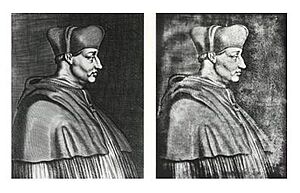Heliography facts for kids
Heliography (say: hee-lee-OG-ruh-fee) is an early way of making pictures using light. The name comes from Greek words: helios meaning "sun" and graphein meaning "writing." So, it means "sun writing."
This amazing process was invented by Joseph Nicéphore Niépce around 1822. He used it to create the very first known photograph taken from nature, called View from the Window at Le Gras (made in 1826 or 1827). Heliography also helped create ways to copy artworks, like photolithography and photogravure.
Contents
How Heliography Was Invented
Nicéphore Niépce started experimenting with making pictures using light in 1811. He wanted to find a way to print images that were etched by light.
Niépce knew about a substance called Bitumen of Judea. This material was used in etching and became harder when exposed to light. He tried coating plates made of glass, zinc, copper, silver, and even pewter with this bitumen.
He found that the parts of the plate that got the most light became hard. These hard areas would not dissolve in oil of lavender and petroleum. The parts that stayed in shadow, and didn't get much light, remained soft. These soft areas could then be etched with acid to create a printing plate. This plate could then print black ink.
By 1822, Niépce made his first light-resistant copy of an engraving. He did this without a lens. He simply placed the original print directly on top of the light-sensitive plate. In 1826, he started using pewter plates more often. Their shiny surface made the images easier to see.
In 1829, Niépce wrote about his experiments. He explained his goal to use heliography to make master plates for printing many copies of images. Even though heliography didn't fully achieve his goals during his lifetime, his nephew, Claude Félix Abel Niépce de Saint-Victor, continued his work. In 1855, they successfully etched heliographs and made prints from them. This laid the groundwork for later photoengraving methods.
Capturing Pictures with a Camera
After returning from London, Niépce focused on making pictures with a camera. He called these pictures "points of view" in his letters. In 1816, he tried using light-sensitive paper in a homemade camera obscura. He managed to get images of the view from his window. However, these images did not last.
It is known that in the summer of 1826, Niépce finally succeeded in making permanent photographic images. He used a lens to project the scene onto a plate inside a camera obscura. Some experts believe the very first such image was made as early as 1822.
The process was very slow. Some think the exposure time might have been eight hours. Others, who have tried to recreate the technique, believe it took three or more days!
Leading to the Daguerreotype
The famous View from the Window at Le Gras was made on a pewter plate. This plate looks like a negative or a positive image depending on how the light hits it. If you look at the plate from the right angle, the dark areas reflect less light. The lighter bitumen film reflects more light. This creates a clear, positive picture of buildings, a tree, and the landscape.
This was similar to the daguerreotype, another early photography method. The daguerreotype was based on Niépce's discoveries. In 1826, a man named Louis Daguerre learned that Niépce was using bitumen to print images on pewter. Niépce had also started using iodine vapors to darken the light parts of his camera images on silver plates. This made them look like positive pictures. Daguerre and Niépce began writing to each other, but both were careful not to share too much about their progress.
Working with Daguerre
Niépce and Daguerre decided to work together. They formed a company on December 14, 1829.
Daguerre liked the "negative" image that bitumen produced. Together, they invented a new process called the physautotype. This method used the light-sensitive leftovers from oil of lavender mixed with alcohol. Like the daguerreotype, the image would appear positive or negative depending on the angle of the light.
Daguerre kept working to improve the process. He used iodine because it was very sensitive to light when applied as a vapor to silver plates. This led Daguerre to create the daguerreotype process. In this method, mercury fumes helped bring out the hidden image on silver iodide plates that had been exposed to light in a camera.
Daguerre likely made his first successful daguerreotypes around 1834. After Niépce passed away, Daguerre formed a new partnership with Niépce's son, Isidore, in 1835. They changed the company name to "Daguerre and Isidore Niépce." On September 27, 1835, Daguerre announced the invention as his own. Daguerre's very successful process came directly from his partnership with Niépce. Sadly, Niépce's own discoveries, which were never fully completed, became less well known.
The Science Behind It
Bitumen is a complex substance made of many linked carbon rings. It also contains small amounts of nitrogen and sulfur. When bitumen is exposed to light, these rings link together even more. This makes the bitumen harder. This is similar to how tree resins also harden when exposed to light. Scientists are still studying the exact chemical reactions that happen during this process.
Other Early Photo Methods
Here are some other early ways people made photographs:
- Physautotype (around 1832)
- Daguerreotype (around 1835)
- Calotype (also Talbotype, around 1835)
- Ambrotype (around 1850)
- Ferrotype (tintype; around 1850)
- Collodion wet plate (around 1850)
- Wothlytype (1864)




